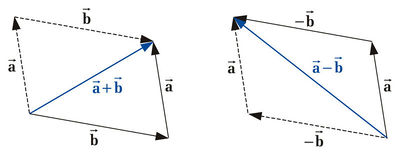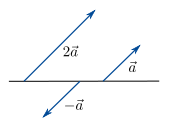Difference between revisions of "Simple arithmetic operations"
| Line 26: | Line 26: | ||
===Multiplication of vectors with scalars=== | ===Multiplication of vectors with scalars=== | ||
[[File:vectoralgebra_multiplication_scalar.png|right|350px]] | [[File:vectoralgebra_multiplication_scalar.png|right|350px]] | ||
| − | + | The multiplication of a vector <math>\vec{\textbf{a}}</math> with a positive real scalar <math>\lambda</math> results in a new vector whose direction suits the direction of the initial vector. A negative <math>\lambda</math> leads to a vector with opposite direction. In both cases the length of the new vector changes with the factor <math>|\lambda|</math>. This is obvious because each component of the vector is multiplied with the scalar: | |
| − | |||
:<math> | :<math> | ||
\lambda \begin{bmatrix} a_x\\a_y\\a_z \end{bmatrix} = \begin{bmatrix} \lambda a_x\\ \lambda a_y\\ \lambda a_z \end{bmatrix} | \lambda \begin{bmatrix} a_x\\a_y\\a_z \end{bmatrix} = \begin{bmatrix} \lambda a_x\\ \lambda a_y\\ \lambda a_z \end{bmatrix} | ||
Revision as of 10:53, 15 May 2014
| ← Back: Unit vectors | Overview: Vector algebra | Next: Dot product → |
Addition and subtraction of vectors
Vectors can be added graphically as well as computationally. Using the graphical method, one of the vectors is shifted such that its startpoint is positioned at the endpoint of the other vector. The resulting vector is called sum vector. It starts at the startpoint the one vector and ends at the endpoint of the shifted vector (see figure on the right). For the computational addition the single components are added
Both the graphical and the computational addition show, that the commutative law holds:
The resulting vector of the substraction of vectors is called difference vector. Because  the two vectors can just be added after inverting the direction of the second vector (see figure on the right). For the computational method the components are substracted:
the two vectors can just be added after inverting the direction of the second vector (see figure on the right). For the computational method the components are substracted:
If more than two vectors are added or substracted the same relations hold. Using the graphical method for example, all the vectors are stringed together.
Multiplication of vectors with scalars
The multiplication of a vector  with a positive real scalar
with a positive real scalar  results in a new vector whose direction suits the direction of the initial vector. A negative
results in a new vector whose direction suits the direction of the initial vector. A negative  leads to a vector with opposite direction. In both cases the length of the new vector changes with the factor
leads to a vector with opposite direction. In both cases the length of the new vector changes with the factor  . This is obvious because each component of the vector is multiplied with the scalar:
. This is obvious because each component of the vector is multiplied with the scalar:
Bei der Multiplikation mit einem Skalar  erhält man als Sonderfall den Nullvektor
erhält man als Sonderfall den Nullvektor  mit dem Betrag
mit dem Betrag  und unbestimmter Richtung. Ein praktisches Beispiel für die Multiplikation eines Vektors mit einem Skalar findet sich in der Einführung in die Vektorrechnung.
und unbestimmter Richtung. Ein praktisches Beispiel für die Multiplikation eines Vektors mit einem Skalar findet sich in der Einführung in die Vektorrechnung.
Multimedial educational material
|
http://mathcasts.org/gg/student/matrices/vectors_adding/index_s.html Applet: Vector addition in cartesian coordinates http://demonstrations.wolfram.com/VectorsIn3D/ Applet: Vector addition in three-dimensional space (free CDF-Player of Wolfram required) http://demonstrations.wolfram.com/3DVectorDecomposition/ Applet: Vector addition in in three-dimensional space with three vectors (free CDF-Player required) http://www.math.ethz.ch/~lemuren/public/visualization/analysis/RealComputation.html Applet: Vector addition in two-dimensional space http://demonstrations.wolfram.com/SumOfTwoVectors/ Applet: Vector addition in cartesian coordinates (free CDF-Player of Wolfram required) |
Helpful links
|
http://hyperphysics.phy-astr.gsu.edu/hbase/vect.html General introduction to vector operations |







